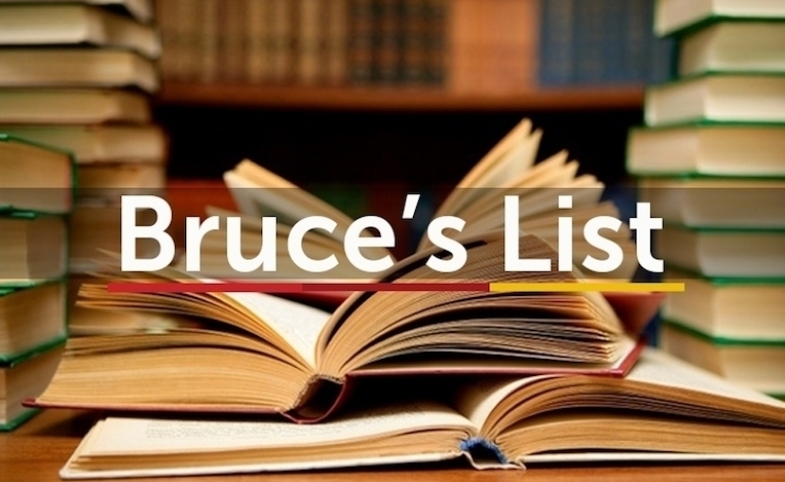
LATEST MUST-READS IN PUBLIC DIPLOMACY: JANUARY 2019
The January edition of CPD Faculty Fellow Bruce Gregory's public diplomacy reading list is now available. Known affectionately at CPD as "Bruce's List," this list is a compilation of books, journal articles, papers and blogs on a wide variety of PD topics and features a number of CPD scholars.
Highlights from this latest list include:
Mieczysław P. Boduszyński, Public Diplomacy and the American Fortress Embassy: Balancing Mission and Security, CPD Perspectives, University of Southern California Center on Public Diplomacy, December 2018. Boduszyński (Pomona College) draws on personal diplomatic experience, interviews with current and retired diplomats, and a survey of relevant policy and practitioner literature in this assessment of one of diplomacy’s hard problems: how should diplomats and foreign ministries responsibly manage risk and simultaneously engage in effective public diplomacy? His central argument is that “a culture of extreme risk aversion at ‘fortress embassies’ has hampered the ability of the State Department to effectively carry out public diplomacy programs” with consequent harm to U.S. foreign policy objectives. Boduszyński’s thoughtful paper effectively frames important issues, examines historical challenges reaching back to the U.S. embassy bombing in Beirut in 1983, provides views of numerous practitioners, and offers policy recommendations for changing the imbalance between mission and security in “high threat” diplomatic posts.
Ali Fisher, Netwar in Cyberia: Decoding the Media Mujahidin, CPD Perspectives, University of Southern California Center on Public Diplomacy, October 2018. Former CPD Research Fellow Ali Fisher draws on his knowledge of public diplomacy, netwar strategies and digital technologies in this analysis of the increasingly effective use of digital platforms and online audiovisual content by jihadist groups. He argues public diplomacy “cannot keep pace with the speed, agility, and resilience of the Media Mujahidin and their communication techniques.” His 113-page paper explores ways to understand and assess information dissemination systems used in jihadist strategies. Based on his data analysis, Fisher calls for a more networked approach in public diplomacy’s interaction with foreign publics and strategies that effectively navigate the languages, ideas, digital platforms, knowledge barriers and credibility gaps in approaches to jihadist movements.
Open Doors 2018, Institute of International Education (IIE) and Bureau of Educational and Cultural Affairs (ECA), U.S. Department of State, released November 13, 2018. The latest IIE report on flows of international students in the United States and U.S. students studying abroad presents a mixed picture. International students in the US have reached a new high of 1.09 million, due primarily to the lingering effect of high enrollment before 2016 and increased participation in a special practical training program for up to 12 months (36 months in STEM fields) following completion of their academic programs. U.S. students abroad grew by 2.3 percent to 332,727. New international student enrollments in the U.S. fell by 6.6 percent in 2017/18 “continuing a slowing or downward trend first observed in the 2015/16 academic year.” See also, Catherine Rampell, “One of America’s Greatest Exports is in Trouble,” December 13, 2018, The Washington Post, and Angel Cabrera, “Make America Welcoming to International Students Again,” November 13, 2018, The Washington Post.
Adam B. Ellick and Adam Westbrook, “Operation Infektion: Russian Disinformation from Cold War to Kanye,” Opinion Video Series, The New York Times, November 2018. New York Times correspondent Ellick and film actor Westbrook have produced a three part online film series on Russia’s decades long use of disinformation and fake news against the West. Episode one looks at the Soviet Union’s pre-Internet campaign to portray AIDS as a U.S. biological weapon in 1984. Episode two examines how “the seven rules of Soviet disinformation” are used in fake news stories today. Episode three explores ways in which governments worldwide are responding to disinformation. The episodes are approximately 15 minutes each and can be viewed on The New York Times website. (Courtesy of Len Baldyga).
The full list, including more pieces by Ali Fisher, CPD Faculty Fellows Nicholas J. Cull and Rhonda Zaharna, and CPD Blog Contributors Sarah Alaoui, Lisa Gibson, Ilan Manor, Xin Liu and Olga Krasnyak, is available here.
Visit CPD's Online Library
Explore CPD's vast online database featuring the latest books, articles, speeches and information on international organizations dedicated to public diplomacy.
Popular Blogs
-
November 3
-
November 5
-
November 13
-
November 25
-
December 17







